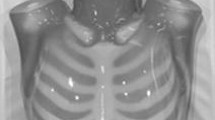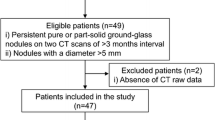Abstract
Objectives
To optimize the slice thickness/overlap parameters for image reconstruction and to study the effect of iterative reconstruction (IR) on detectability and characterization of small non-calcified pulmonary nodules during low-dose thoracic CT.
Materials and methods
Data was obtained from computer simulations, phantom, and patient CTs. Simulations and phantom CTs were performed with 9 nodules (5, 8, and 10 mm with 100, −630, and −800 HU). Patient data were based on 11 ground glass opacities (GGO) and 9 solid nodules. For each analysis the nodules were reconstructed with filtered back projection and IR algorithms using 10 different combinations of slice thickness/overlap (0.5–5 mm). The attenuation (CT#) and the contrast to noise ratio (CNR) were measured. Spearman’s coefficient was used to correlate the error in CT# measurements and slice thickness. Paired Student’s t test was used to measure the significance of the errors.
Results
CNR measurements: CNR increases with increasing slice thickness/overlap for large nodules and peaks at 4.0/2.0 mm for smaller ones. Use of IR increases the CNR of GGOs by 60 %.
CT# measurements: Increasing slice thickness/overlap above 3.0/1.5 mm results in decreased CT# measurement accuracy.
Conclusion
Optimal detection of small pulmonary nodules requires slice thickness/overlap of 4.0/2.0 mm. Slice thickness/overlap of 2.0/2.0 mm is required for optimal nodule characterization. IR improves conspicuity of small ground glass nodules through a significant increase in nodule CNR.
Key Points
• Slice thickness/overlap affects the accuracy of pulmonary nodule detection and characterization.
• Slice thickness ≥3 mm increases the risk of misclassifying small nodules.
• Optimal nodule detection during low-dose CT requires 4.0/2.0-mm reconstructions.
• Optimal nodule characterization during low-dose CT requires 2.0/2.0-mm reconstructions.
• Iterative reconstruction improves the CNR of ground glass nodules by 60 %.








Similar content being viewed by others
References
Jemal A, Siegel R, Xu J, Ward E (2010) Cancer statistics, 2010. CA Cancer J Clin 60:277–300
Beadsmoore C, Screaton N (2003) Classification, staging and prognosis of lung cancer. Eur J Radiol 45:8–17
International Early Lung Cancer Action Program Investigators, Henschke CI, Yankelevitz DF et al (2006) Survival of patients with stage I lung cancer detected on CT screening. N Engl J Med 355(17):1763–71
MacMahon H, Austin JH, Gamsu G et al (2005) Fleischner society guidelines for management of small pulmonary nodules detected on CT scans: a statement from the Fleischner society. Radiology 237:395–400
Henschke C, McCauley D, Yankelevitz D et al (1999) Early lung cancer action project: overall design and findings from baseline screening. Lancet 354:99–105
National Lung Screening Trial Research Team, Aberle DR, Adams AM et al (2011) National lung screening trial research team reduced lung-cancer mortality with low-dose computed tomographic screening. N Engl J Med 365:395–409
Goodsitt MM, Chan HP, Way TW, Larson SC, Christodoulou EG, Kim J (2006) Accuracy of the CT numbers of simulated lung nodules imaged with multi-detector CT scanners. Med Phys 33:3006–3017
Ravenel JG, Leue WM, Nietert PJ, Miller JV, Taylor KK, Silvestri GA (2008) Pulmonary nodule volume: effects of reconstruction parameters on automated measurements—a phantom study. Radiology 247:400–408
Lifeng Y, Liu X, Leng S et al (2009) Radiation dose reduction in computed tomography: techniques and future perspective. Imaging Med 1:65–84
Henschke CI, Yankelevitz DF, Mirtcheva R, McGuinness G, McCauley D, Miettinen OS, ELCAP Group (2002) CT screening for lung cancer: frequency and significance of part-solid and nonsolid nodules. AJR Am J Roentgenol 178:1053–1057
Goo JM, Park CM, Lee HJ (2011) Ground-glass nodules on chest CT as imaging biomarkers in the management of lung adenocarcinoma. AJR Am J Roentgenol 196:533–543
Xu DM, van Klaveren RJ, de Bock GH et al (2009) Role of baseline nodule density and changes in density and nodule features in the discrimination between benign and malignant solid indeterminate pulmonary nodules. Eur J Radiol 70:492–498
Fischbach F, Knollmann F, Griesshaber V, Freund T, Akkol E, Felix R (2003) Detection of pulmonary nodules by multislice computed tomography: improved detection rate with reduced slice thickness. Eur Radiol 13:2378–2383
Petrou M, Quint LE, Nan B, Baker LH (2007) Pulmonary nodule volumetric measurement variability as a function of CT slice thickness and nodule morphology. AJR Am J Roentgenol 188:306–312
Diederich S, Lentschig MG, Winter F, Roos N, Bongartz G (1999) Detection of pulmonary nodules with overlapping vs. non-overlapping image reconstruction at spiral CT. Eur Radiol 9:281–286
Gavrielides MA, Zeng R, Myers KJ, Sahiner B, Petrick N (2013) Benefit of overlapping reconstruction for improving the quantitative assessment of CT lung nodule volume. Acad Radiol 20:173–180
Honda O, Sumikawa H, Johkoh T et al (2007) Computer-assisted lung nodule volumetry from multi-detector row CT: influence of image reconstruction parameters. Eur J Radiol 62:106–113
Katsura M, Matsuda I, Akahane M et al (2012) Model-based iterative reconstruction technique for radiation dose reduction in chest CT: comparison with the adaptive statistical iterative reconstruc. Eur Radiol 22:1613–1623
Therasse P, Arbuck SG, Eisenhauer EA et al (2000) New guidelines to evaluate the response to treatment in solid tumors (RECIST Guidelines). J Natl Cancer Inst 92:205–216
Gramer BM, Muenzel D, Leber V et al (2012) Impact of iterative reconstruction on CNR and SNR in dynamic myocardial perfusion imaging in an animal model. Eur Radiol 22:2654–2661
Li Q, Yu H, Zhang L, Fan L, Liu SY (2013) Combining low tube voltage and iterative reconstruction for contrast-enhanced CT imaging of the chest-initial clinical experience. Clin Radiol 68:e249–e253
Yanagawa M, Tanaka Y, Kusumoto M et al (2010) Automated assessment of malignant degree of small peripheral adenocarcinomas using volumetric CT data: correlation with pathologic prognostic factors. Lung Cancer 70:286–294
Whiting BR (2002) Signal statistics in X-ray computed tomography. Proc SPIE 4682, Med Imaging 2002. Phys Med Imaging. doi:10.1117/12.465601
Knight K (2000) Mathematical statistics. Chapman and Hall, New York (proposition 2.11)
Multipurpose Chest Phantom N1. Kyoto Kagaku Co. [Online]. Available from http://www.kyotokagaku.com/products/detail03/ph-1.html
Paul NS, Blobel J, Prezelj E et al (2010) The reduction of image noise and streak artifact in the thoracic inlet during low dose and ultra-low dose thoracic CT. Phys Med Biol 55:1363–1380
Schindera ST, Odedra D, Raza SA et al (2013) Iterative reconstruction algorithm for CT: can radiation dose be decreased while low-contrast detectability is preserved? Radiology. doi:10.1148/radiol.13122349
Iwano S, Makino N, Ikeda M, Itoh S et al (2004) Solitary pulmonary nodules: optimal slice thickness of high-resolution CT in differentiating malignant from benign. Clin Imaging 28:322–328
Sinsuat M, Saita S, Kawata Y et al (2011) Influence of slice thickness on diagnoses of pulmonary nodules using low-dose CT: potential dependence of detection and diagnostic agreement on features and location of nodule. Acad Radiol 18:594–604
Acknowledgements
The scientific guarantor of this publication is Dr. Narinder Paul. The authors of this manuscript declare relationships with the following companies: Toshiba Medical Systems.
This study has received funding by MITACS Accelerate. This study was partially supported by Toshiba Canada, Medical Systems Group, and MITACS accelerate. No complex statistical methods were necessary for this paper. Institutional review board approval was obtained. Written informed consent was waived by the institutional review board. Some study subjects or cohorts have been previously reported in ECR 2012. Methodology: retrospective, randomised controlled trial, performed at one institution
Author information
Authors and Affiliations
Corresponding author
Rights and permissions
About this article
Cite this article
Hashemi, S., Mehrez, H., Cobbold, R.S.C. et al. Optimal image reconstruction for detection and characterization of small pulmonary nodules during low-dose CT. Eur Radiol 24, 1239–1250 (2014). https://doi.org/10.1007/s00330-014-3142-9
Received:
Revised:
Accepted:
Published:
Issue Date:
DOI: https://doi.org/10.1007/s00330-014-3142-9




